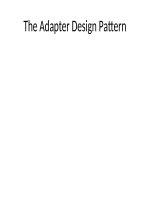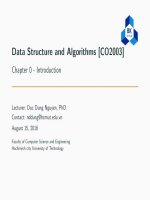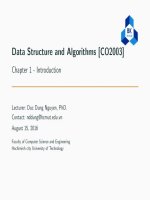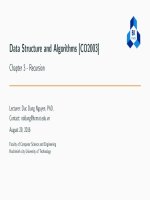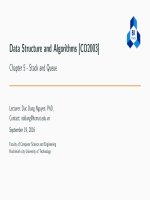C++ programming program design including data structure 7th ch04
Bạn đang xem bản rút gọn của tài liệu. Xem và tải ngay bản đầy đủ của tài liệu tại đây (1 MB, 58 trang )
Chapter 4:
Control Structures I (Selection)
Objectives
• In this chapter, you will:
– Learn about control structures
– Examine relational operators
– Discover how to use the selection control structures if,
if…else
– Examine int and bool data types and logical (Boolean)
expressions
– Examine logical operators
C++ Programming: Program Design Including Data Structures, Seventh Edition
2
Objectives (cont’d.)
– Explore how to form and evaluate logical (Boolean)
expressions
– Learn how relational operators work with the string
type
– Become aware of short-circuit evaluation
– Learn how the conditional operator, ?:, works
– Learn how to use pseudocode to develop, test, and debug
a program
C++ Programming: Program Design Including Data Structures, Seventh Edition
3
Objectives (cont’d.)
– Discover how to use a switch statement in a program
– Learn how to avoid bugs by avoiding partially understood
concepts
– Learn how to use the assert function to terminate a
program
C++ Programming: Program Design Including Data Structures, Seventh Edition
4
Control Structures
• A computer can proceed:
–
–
–
–
In sequence
Selectively (branch): making a choice
Repetitively (iteratively): looping
By calling a function
• Two most common control structures:
– Selection
– Repetition
C++ Programming: Program Design Including Data Structures, Seventh Edition
5
Control Structures (cont’d.)
C++ Programming: Program Design Including Data Structures, Seventh Edition
6
Selection: if and if...else
• Execution of selection or repetition requires
execution of a logical expression:
– Evaluates to true or false
– “8 is greater than 3”
C++ Programming: Program Design Including Data Structures, Seventh Edition
7
Relational Operators (cont’d.)
C++ Programming: Program Design Including Data Structures, Seventh Edition
8
Relational Operators and Simple Data
Types
• Conditional statements: only executed if certain
conditions are met
• Condition: represented by a logical (Boolean)
expression that evaluates to a logical (Boolean) value
of true or false
• Relational operators:
– Allow comparisons
– Require two operands (binary)
– Evaluate to true or false
C++ Programming: Program Design Including Data Structures, Seventh Edition
9
Relational Operators and Simple Data
Types (cont’d.)
• Relational operators can be used with all three
simple data types:
8 < 15 evaluates to true
6 != 6 evaluates to false
2.5 > 5.8 evaluates to false
5.9 <= 7.5 evaluates to true
C++ Programming: Program Design Including Data Structures, Seventh Edition
10
Comparing Characters
• Expression of char values with relational operators
– Result depends on machine’s collating sequence
– ASCII character set
• Logical (Boolean) expressions
– Expressions such as 4 < 6 and 'R' > 'T’
– Returns an integer value of 1 if the logical expression
evaluates to true
– Returns an integer value of 0 otherwise
C++ Programming: Program Design Including Data Structures, Seventh Edition
11
One-Way Selection
• One-way selection syntax:
• Statement is executed if the value of the expression
is true
• Statement is bypassed if the value is false;
program goes to the next statement
• Expression is called a decision maker
C++ Programming: Program Design Including Data Structures, Seventh Edition
12
One-Way Selection (cont’d.)
C++ Programming: Program Design Including Data Structures, Seventh Edition
13
Two-Way Selection
• Two-way selection syntax:
• If expression is true, statement1 is executed;
otherwise, statement2 is executed
– statement1 and statement2 are any C++ statements
C++ Programming: Program Design Including Data Structures, Seventh Edition
14
Two-Way Selection (cont’d.)
C++ Programming: Program Design Including Data Structures, Seventh Edition
15
The int Data Type and Logical
(Boolean) Expressions
• Earlier versions of C++ did not provide built-in data
types that had Boolean values
• Logical expressions evaluate to either 1 or 0
– Logical expression value was stored in a variable of the
data type int
• Can use the int data type to manipulate logical
(Boolean) expressions
C++ Programming: Program Design Including Data Structures, Seventh Edition
16
bool Data Type and Logical (Boolean)
Expressions
• The data type bool has logical (Boolean) values
true and false
• bool, true, and false are reserved words
• The identifier true has the value 1
• The identifier false has the value 0
C++ Programming: Program Design Including Data Structures, Seventh Edition
17
Logical (Boolean) Operators and
Logical Expressions
• Logical (Boolean) operators: enable you to combine
logical expressions
C++ Programming: Program Design Including Data Structures, Seventh Edition
18
Logical (Boolean) Operators and
Logical Expressions (cont’d.)
C++ Programming: Program Design Including Data Structures, Seventh Edition
19
Logical (Boolean) Operators and
Logical Expressions (cont’d.)
C++ Programming: Program Design Including Data Structures, Seventh Edition
20
Logical (Boolean) Operators and
Logical Expressions (cont’d.)
C++ Programming: Program Design Including Data Structures, Seventh Edition
21
Order of Precedence
• Relational and logical operators are evaluated from
left to right
– The associativity is left to right
• Parentheses can override precedence
C++ Programming: Program Design Including Data Structures, Seventh Edition
22
Order of Precedence (cont’d.)
C++ Programming: Program Design Including Data Structures, Seventh Edition
23
Order of Precedence (cont’d.)
C++ Programming: Program Design Including Data Structures, Seventh Edition
24
Order of Precedence (cont’d.)
C++ Programming: Program Design Including Data Structures, Seventh Edition
25

